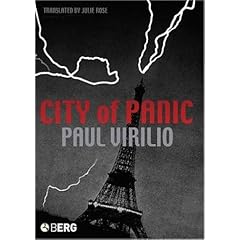
... intellectually, rhetorically and emotionally: Paul Virilio's 2004 treatise (released in an English translation by Julie Rose in 2005), City of Panic. Written in the shadow of 9/11 and the new Gulf war/the war on terror, but also linking brilliantly to the increasing bunkerization of societies (urban and otherwise), the still inadequately understood ramifications of virtual/networked culture, the intermittent urban blackouts of the past decade and even the X Prize (recently considered in a totally different, more positive light here), City of Panic is a typically perspicacious Virilio text, if an atypically bleak one.
The following two passages, among the more dire, sum up the book's urgent primary argument with some concision:
Describing NYC, Baghdad, Jerusalem, Hong Kong but also explicitly all cities: “CITIES OF PANIC that signal, more clearly than all the theories about urban chaos, the fact that the greatest catastrophe of the twentieth century has been the city, the contemporary metropolis of the disasters of Progress.” City of Panic, 90, emphasis in the original
“FORECLOSURE, EXCLUSION… Megalopolitan hyperconcentration is now topped not only with mass hyperterrorism, but also a panicky delinquency that is dragging the human race back to the original dance of death. The city once more becomes a citadel, in other words, a target for all terrors, domestic or strategic.” City of Panic, 95, emphasis in the original
Grim observations but from a prescient thinker on cities, culture, militarism ... and on the militarization of both cities and culture. Once we get past the rhetorical challenges I refer to at the beginning of this post ("megalopolitan hyperconcentration"?), must we de facto accept the challenging conclusions Virilio draws? Are cities doomed, and citizens everywhere along with them?
No comments:
Post a Comment